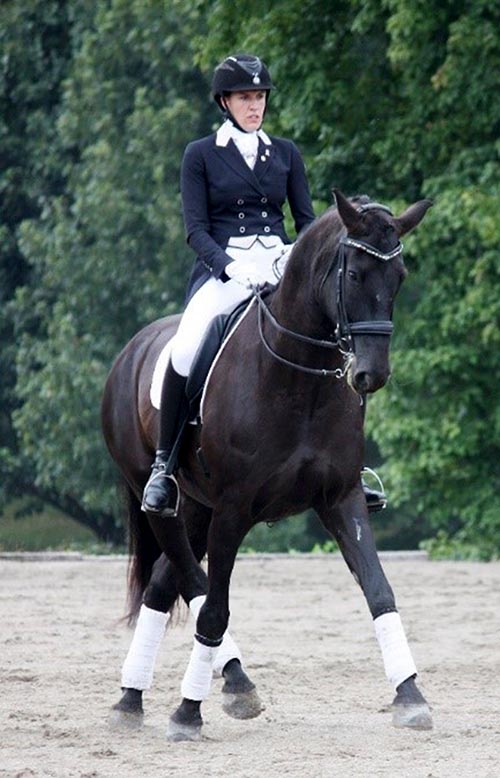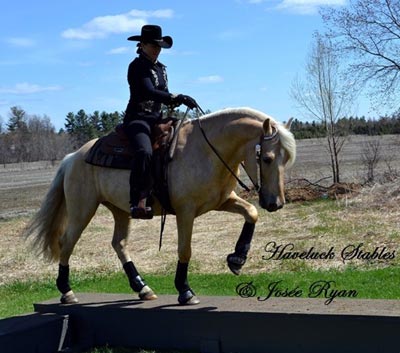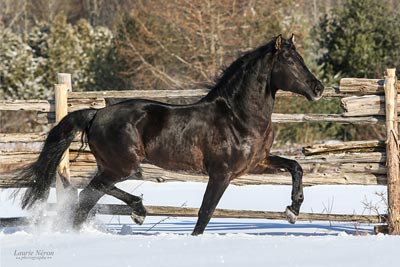
by Liz Piacentini
Canada’s best kept secret is out! The Canadian Horse is successfully participating in just about every discipline. While not well known, the Canadian once played a vital role in Canadian and US history. Recognized as the National Horse of Canada since 2002, the Canadian is big in heart and strength, making the breed both a serious competitor and enjoyable equine partner.
The Canadian horse, or le Cheval Canadien, has been part of North American history for over 350 years. The breed’s ancestors originated from the Royal Stables of France where King Louis XIV housed his collection of over 2,000 horses of the finest stock.
When the French settled Quebec, King Louis XIV recognized early settlers would require horses. Between 1665-1671, he sent several shipments of carefully selected horses to help develop this rugged new land that was void of existing herds. He chose horses with strength and soundness to help settlers clear and farm the land, yet elegant enough to transport Noblemen and Clergy. According to a 2014 Texas A&M genetic study conducted by E. Gus Cothran, the original mares and stallions were likely of Breton, Norman and Belgian stock.
The Canadian horse quickly became the early settlers’ biggest asset. His compact, muscular body, thick winter coat, rock-hard feet, and willing attitude earned him the nickname, “the Little Iron Horse." For 200 years, the founding herd bred in relative isolation, becoming a genetically distinct breed. By the mid-1800’s, the population reached an estimated 150,000 horses and earned the reputation for out-pulling and out-working larger breeds.
Breed numbers took a drastic turn in the 1860’s. During the Civil War, the US Army imported thousands of Canadian horses. Union soldiers valued their brave natures, strength for pulling artillery, and (unlike draft horses) preferred size for riding. While the Canadian horse may have helped the North claim victory, sadly, approximately 30,000 Canadians died during the Civil War. Those who survived often lost any identity with a specific breed.
The Canadian was exported from his native land for additional wars and cross-breeding. Gradually, he became replaced by mechanization. By the mid-1970’s, breed numbers dipped to a low of around 400 registered horses. Today, the Canadian is listed as critically endangered by the Livestock Conservancy and the Equus Survival Trust and has a current population hovering around 6,500 worldwide. Passionate breeders, owners and organizations such as the Canadian Horse Heritage & Preservation Society (CHHAPS) and the Canadian Horse Breeders Association (CHBA) are striving to save the breed from extinction.
The Livestock Conservancy describes the breed as being “solid and well-muscled, with a well-arched neck set high on a long, sloping shoulder. The overall impression is one of a round, sturdy and well-balanced horse [that is] energetic without being nervous.”

Today’s Canadian reflects its history of athleticism, stamina, versatility and strong bone, making the breed an excellent choice for your favorite discipline. This breed is admired for their movement and suspension (Canadians are warmblood eligible), thick wavy mane and tail, intelligence and even temperament.
Considered easy-keepers, Canadian’s love variety and excel at the National level in many disciplines including Dressage, Eventing, competitive trail, driving, and working equitation. You can even find the Canadian horse in ranch work, Western disciplines, the mounted police, and foxhunting – even mounted archery and skijoring! Discover a Canadian horse and fall in love with a breed that’s happy to embrace your favorite discipline.
To learn more about the Canadian horse, meet breeders and owners, come to the Canadian Horse Expo, being held October 13 in Harwinton, CT. Find out more in our Events - Recreation & Lifestlye section.
Find out more in Horse Breeds - Canadian Horse right here on EIE.
All photos courtesy of the Canadian Horse Breeders Association.




































